Exploring Grubhub Data Scraping Services to Track Restaurant Menus, Reviews, and Delivery Trends
Sep 09
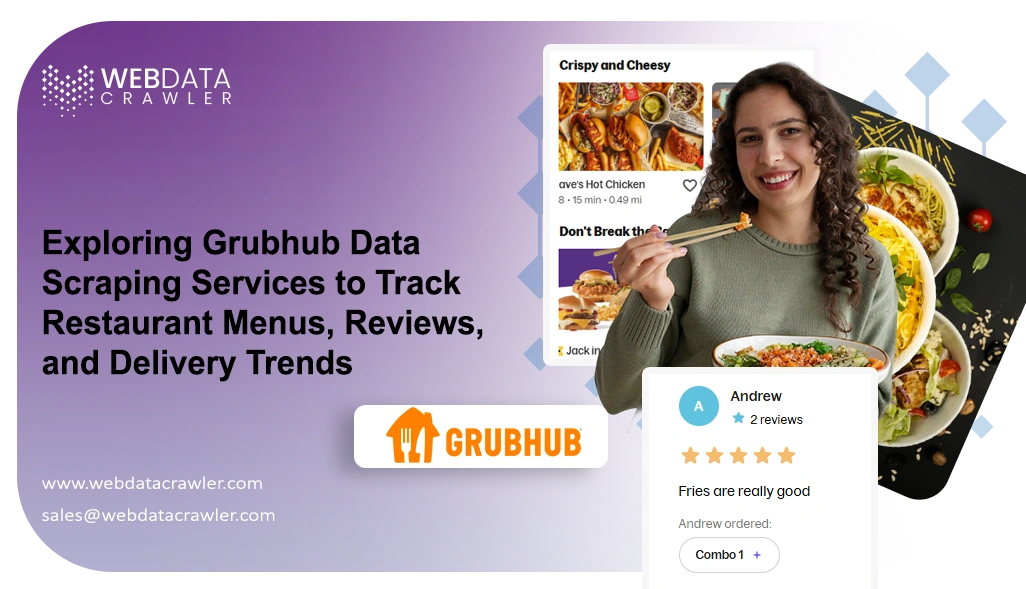
Introduction
In today’s digital-first food industry, access to structured, real-time data is becoming a game-changer for restaurants, delivery platforms, and market researchers. Platforms like Grubhub serve millions of users daily, making it a goldmine of insights into customer preferences, trending cuisines, and delivery behaviors. Businesses that rely solely on traditional market research often miss the depth and accuracy required to adapt quickly. This is where Grubhub Data Scraping Services step in, allowing businesses to extract valuable information about menus, pricing, reviews, and delivery patterns with ease.
By implementing advanced automation techniques, businesses can track competitor strategies, optimize their menu offerings, and gain a deeper understanding of consumer sentiment across multiple locations. For instance, extracting review trends enables restaurants to detect service gaps, while monitoring menu prices supports competitive pricing decisions. This data-driven approach ensures faster adaptation to shifting market demands.
With the increasing use of Mobile App Scraping, brands can also capture insights directly from the Grubhub mobile platform, which many customers use as their primary ordering channel. By collecting data from both desktop and mobile ecosystems, businesses get a complete view of consumer activity. In this way, restaurant operators, aggregators, and food analysts can create strategies that truly resonate with today’s on-demand culture.
Tracking Food Delivery Market Trends
The food delivery industry continues to evolve rapidly, making it essential for businesses to rely on accurate, data-driven insights for more intelligent decision-making. Through Grubhub Menu and Pricing Scraping, companies can effectively track consumer demand, monitor delivery trends, and evaluate operational performance. These insights enable restaurants and delivery platforms to refine their strategies and remain competitive in a rapidly evolving market landscape.
Key advantages include:
- Monitoring which cuisines are gaining popularity across different regions.
- Analyzing peak delivery times to optimize resource allocation.
- Understanding geographic demand variations to improve targeted marketing.
- Studying delivery speed and fees to evaluate competitive positioning.
- Identifying loyalty patterns among repeat customers.
- Benchmarking competitor offerings to refine promotions and bundles.
By integrating these insights, businesses can predict upcoming market shifts and proactively adjust their services. For example, when a particular cuisine gains traction, early adopters can capture customer attention faster. Similarly, delivery fee analysis helps ensure pricing is aligned with customer expectations while still supporting profitability.
Additionally, Grubhub Food Delivery Data Scraping provides structured datasets that reveal long-term delivery behavior. Businesses can utilize this data to build trend analyses, forecast seasonal demands, and enhance their overall operations. The ability to capture real-time shifts in customer preferences ensures organizations remain competitive in the rapidly growing delivery economy.
Optimizing Restaurant Menu Strategies
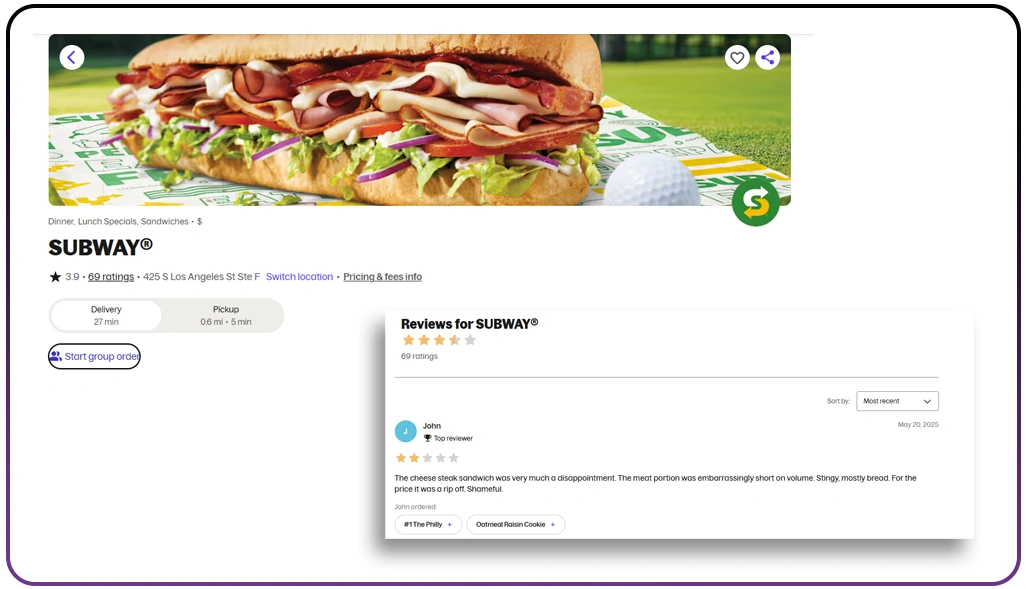
Menus are a vital factor in shaping customer choices, and refining them demands precise insights. Through Grubhub Reviews and Ratings Scraping, businesses can gather valuable data on competitor menus, pricing shifts, and product availability. This empowers restaurants to strategically present their offerings, attract more customers, and maintain profitability.
Key applications include:
- Tracking price fluctuations across competitor menus.
- Analyzing portion sizes and descriptions to enhance presentation.
- Identifying trending dishes that can be added to menus.
- Monitoring seasonal items that drive customer interest.
- Detecting underperforming items to adjust or remove.
- Studying competitor discounts and promotional bundles.
Restaurants can also refine their upselling and cross-selling strategies by studying menu layouts and order patterns. This enables them to highlight popular items or pair complementary dishes more effectively. Moreover, pricing intelligence helps businesses strike the right balance between affordability and profitability.
By implementing Food Data Scraping Services, restaurants can develop data-backed menu strategies that adapt to evolving customer demands. This ensures that they remain relevant in highly competitive markets. For instance, if reviews indicate growing interest in vegan options, businesses can expand their plant-based offerings to attract health-conscious diners.
In essence, menu optimization powered by real-time data scraping enables food businesses to create offerings that resonate with customer expectations while maintaining a competitive edge.
Analyzing Customer Sentiment and Reviews
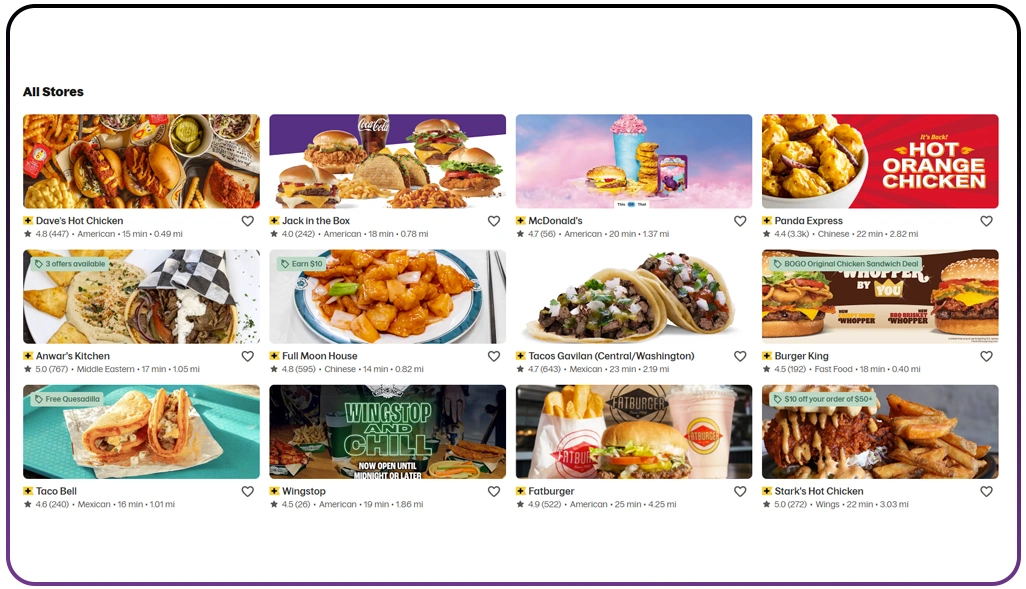
Customer feedback is crucial for establishing a strong restaurant reputation and enhancing service quality. By using the Grubhub Restaurant Listings Data Extractor, businesses can gather extensive reviews and ratings to reveal valuable insights into customer sentiment. These insights enable restaurants to recognize their strengths, address weaknesses, and identify opportunities for ongoing improvement.
Some key use cases include:
- Analyzing recurring customer complaints to address service gaps.
- Tracking high-rated menu items that drive customer loyalty.
- Understanding sentiment trends across multiple geographic locations.
- Comparing competitor ratings for benchmarking service quality.
- Identifying emerging customer expectations based on review language.
- Monitoring long-term changes in brand perception.
Sentiment analysis derived from reviews also helps businesses improve customer experience management. By addressing frequent pain points, such as delivery delays or food quality, brands can build stronger customer trust. On the other hand, highlighting top-rated items allows businesses to reinforce their competitive advantage.
In addition, Popular Food Data Scraping enhances the review analysis process by capturing not only ratings but also detailed text reviews, order feedback, and even delivery driver performance data. This provides a well-rounded understanding of how customers perceive their entire food journey. By utilizing structured review data, businesses can implement more targeted improvements that result in increased customer retention and loyalty.
Improving Market Intelligence with Competitor Analysis
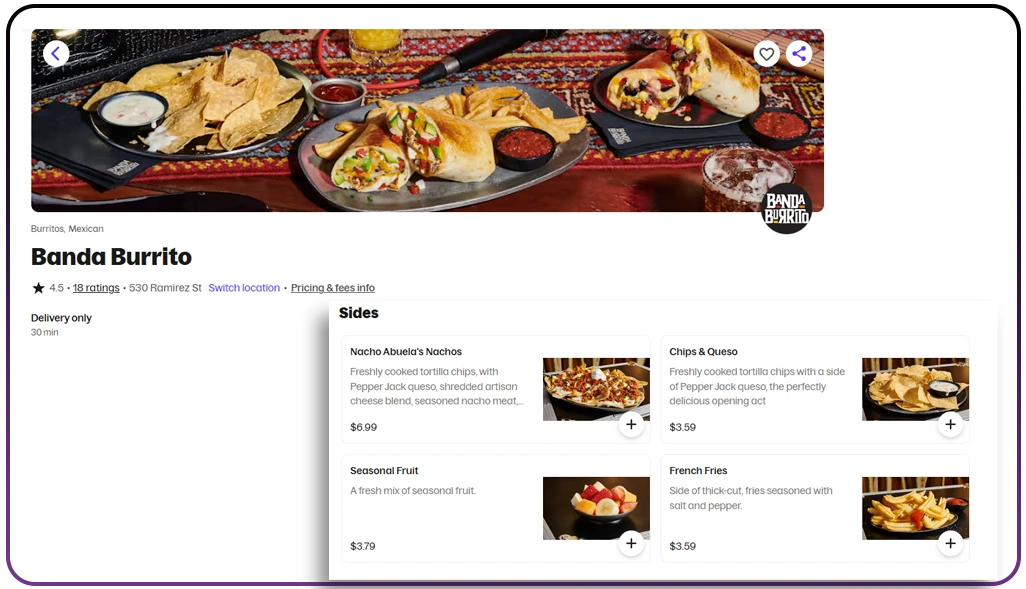
The restaurant industry is highly competitive, where competitor intelligence plays a crucial role in driving sustainable growth. By choosing to Scrape Grubhub Restaurant Menus, businesses can gain valuable insights into competitor pricing, delivery charges, promotional strategies, and customer engagement methods with greater accuracy.
Key benefits include:
- Comparing competitor menu structures and item variety.
- Studying how discounts and promotions affect demand.
- Tracking competitor delivery zones and expansion strategies.
- Analyzing customer sentiment towards rival brands.
- Observing packaging innovations or value-added services.
- Monitoring loyalty rewards that competitors offer.
By integrating these insights, restaurants can identify market gaps and build unique offerings that stand out. For example, a business may discover that a competitor’s popular meal bundle is missing specific dietary options, creating an opportunity to capture underserved segments. Additionally, competitor data can help optimize advertising and promotional budgets. By knowing which campaigns work best for rivals, businesses can refine their own outreach strategies for higher ROI.
Since insights from competitor analysis are highly dynamic, utilizing Web Scraping Services ensures that businesses consistently access fresh, reliable, and structured datasets. This enables real-time decision-making that quickly adapts to market changes. In short, competitor intelligence supported by data scraping enhances strategic foresight, ensuring businesses are always one step ahead in the competitive landscape.
Scaling Data Insights for Enterprise Needs
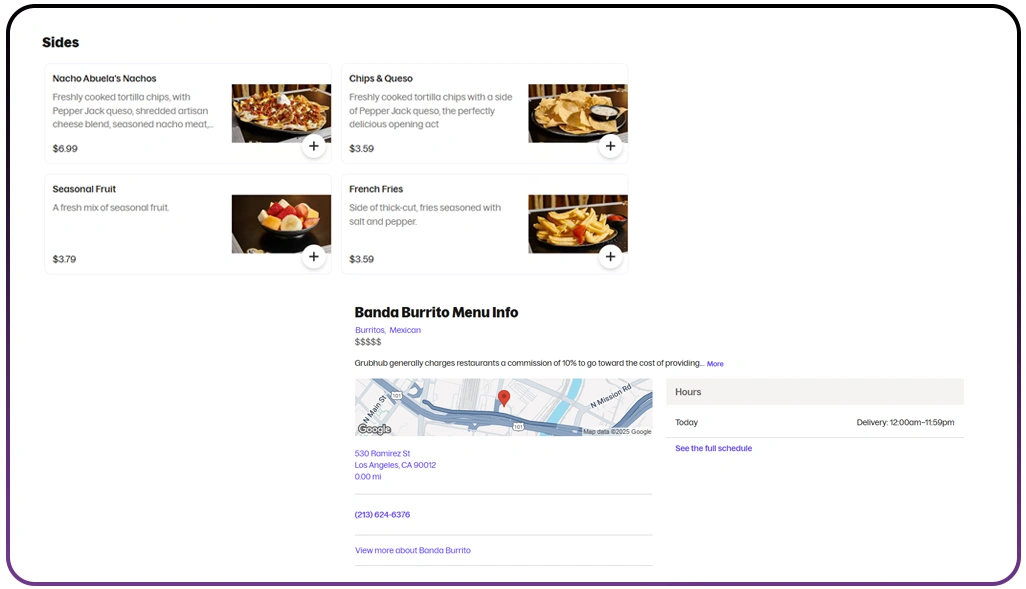
Large-scale food enterprises and aggregators face unique challenges in managing vast amounts of data. Grubhub Data Scraping Services offer scalable solutions that cater to the needs of enterprises managing thousands of locations and customer interactions daily.
Key applications include:
- Automating large-scale data collection across multiple markets.
- Consolidating menu and pricing information from hundreds of restaurants.
- Tracking customer reviews in bulk for sentiment analysis.
- Extracting delivery performance metrics across regions.
- Streamlining competitor monitoring at scale.
- Generating predictive analytics using historical datasets.
With Enterprise Web Crawling, businesses can capture structured data at a massive scale, ensuring high accuracy and reliability. These capabilities allow enterprises to centralize insights and support decision-making across departments, from operations to marketing.
For instance, an enterprise food chain can evaluate menu performance across different cities, identifying which items perform best in each region. Similarly, centralized review analysis can uncover service issues affecting multiple branches. In essence, large-scale scraping solutions help enterprises remain agile and customer-focused, even in a highly competitive marketplace.
Enhancing Integration with APIs and Automation
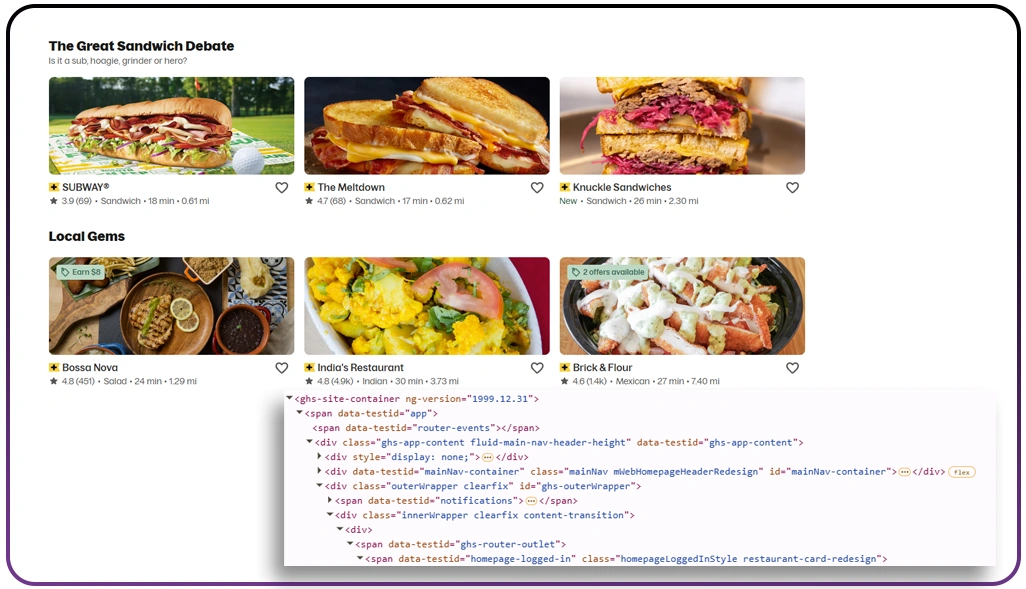
Automation and integration play a crucial role in building efficient data workflows. Through Grubhub API Data Extraction, businesses can extract valuable insights and integrate them effortlessly into their existing systems and analytical dashboards.
Key benefits include:
- Automating routine data extraction tasks to save time.
- Enabling real-time data synchronization across platforms.
- Connecting scraped insights to BI tools for visualization.
- Allowing teams to set custom alerts on data changes.
- Supporting custom queries for targeted datasets.
- Improving collaboration with centralized access to insights.
Using a Web Scraping API, businesses can streamline the flow of data between Grubhub and their internal systems. This ensures decision-makers always have access to the latest insights without manual intervention.
Furthermore, automation enhances productivity by reducing repetitive work and minimizing human errors. Teams can focus more on strategic initiatives rather than routine data gathering.
By integrating scraping results with predictive models, companies can also forecast market behavior, detect anomalies, and optimize resources proactively. Ultimately, automation ensures that food businesses remain efficient, adaptable, and well-prepared for the dynamic changes in the industry.
How Web Data Crawler Can Help You?
When it comes to extracting structured insights, Grubhub Data Scraping Services offer unmatched reliability and efficiency. Businesses across the food industry can rely on us to gather critical information about menus, pricing, reviews, and delivery performance at scale. This empowers decision-makers with accurate data to optimize offerings, refine customer experiences, and strengthen market intelligence strategies.
Here’s how our solutions can make a difference:
- Collect large datasets with precision and speed.
- Support real-time monitoring of restaurant trends.
- Deliver tailored scraping solutions for unique business needs.
- Provide structured outputs ready for analysis.
- Offer integration options with enterprise dashboards.
- Ensure data accuracy with advanced automation.
Our expertise not only helps streamline operations but also ensures scalability for growing businesses. Through continuous innovation, we empower companies to act on reliable insights more quickly and effectively. Whether it’s pricing optimization, review tracking, or competitor monitoring, our services help you maintain a competitive edge.
For businesses requiring diverse Web Scraping Services, we provide comprehensive solutions designed to address every challenge in today’s food data ecosystem.
Conclusion
Data is the foundation of modern food delivery strategies, and Grubhub Data Scraping Services provide the accuracy and depth required for more intelligent business decisions. By analyzing menus, pricing, reviews, and delivery behaviors, businesses can effectively adapt to ever-changing market dynamics. This structured data ensures that restaurants and delivery platforms remain competitive in a digital-first world.
Additionally, solutions like Grubhub Competitor Data Scraping empower businesses to anticipate rival strategies and identify opportunities for differentiation. Whether optimizing menus or monitoring reviews, actionable insights lead to stronger customer engagement and long-term success.
Ready to transform your food business strategies with data-driven insights? Connect with Web Data Crawler today and start making smarter decisions powered by actionable food delivery intelligence.